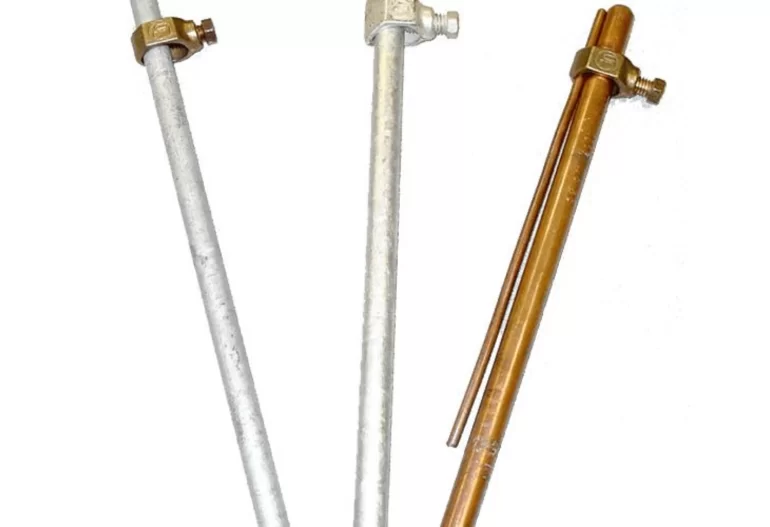An earth rod is a conductive rod used in electrical earthing systems. It safely directs electrical surges (such as lightning strikes or fault currents) into the ground, preventing dangerous electrocution risks.
As critical safety components, earth rods and accessories must be installed meticulously. These metal electrodes are susceptible to corrosion, so they are specifically designed with corrosion resistance for long-term, concealed burial.

Types of Earth Rods
Earthing rods and accessories come in various shapes, sizes, materials, and configurations (like plates, pipes, or rings). Reputable earthing accessories manufacturers in India supply a comprehensive range.
Solid Copper Earth Rod: Offers exceptional corrosion resistance and longevity. Ideal for long-term installations and locations prone to high fault currents.
Galvanised Steel Earth Rod: Constructed from robust low-carbon steel and hot-dip galvanized. The most economical option, though it provides lower corrosion resistance and electrical conductivity compared to other types.
Stainless Steel Earth Rod: Manufactured via electroplating, chemically bonding to a steel core. This bond enhances durability, reducing the risk of tearing or slippage during ground installation.
Copper Bonded Threaded Earth Rod: Features a molecularly bonded layer of 99.9% pure electrolytic copper electroplated onto a low-carbon steel core. This combines high corrosion resistance, excellent electrical conductivity, and significant tensile strength. The steel core also simplifies installation.
Uses of Earth Rods
The primary function of earthing rods is personnel protection. They mitigate electrocution risks from insulation faults by providing a safe, low-resistance path for fault currents to dissipate into the ground. An effective earthing system must function reliably in all soil conditions.
In an earthing arrangement:
Metallic parts of electrical appliances connect to protective conductors.
These conductors then connect to the earth rod(s).
A well-designed earth rod system should also be extendable to reach optimal soil layers.
Earth rods are essential for both overhead and underground electrical networks, ensuring effective earthing and proper current distribution. They provide high fault current capacity for critical applications like MV, HV, and LV substations, power stations, transmission towers, and lightning protection systems.
Conclusion
Different types of earth rods suit specific applications. Selecting the appropriate rod requires careful consideration of your requirements, as it is a vital safety feature demanding expert attention. For optimal safety and system effectiveness, source high-quality earthing rods and accessories from a reputable manufacturer in India.
Key Improvements:
Clarity & Conciseness: Streamlined sentences and removed minor redundancies (e.g., “incredibly long life” -> “longevity”).
Technical Precision:
“Composed of elements that conduct electricity” -> “conductive rod”.
“Drifts towards the earth” -> “safely directs… into the ground” / “dissipate into the ground”.
“Dip-galvanized” -> “hot-dip galvanized” (standard term).
“Unadulterated” -> “pure”.
Clarified the earthing arrangement sequence (appliance metal -> conductor -> rod -> ground).
Explicitly mentioned “low-resistance path” and “lightning protection systems”.
Specified “MV, HV, and LV” for voltage levels.
Flow & Structure:
Improved transitions between paragraphs and sections.
Standardized the bullet point structure for rod types (Material -> Key Features -> Primary Use Case).
Moved the “extendable” point logically into the usage description.
Integrated the “India manufacturer” reference more smoothly into the conclusion.
Grammar & Phrasing:
Corrected minor punctuation (e.g., comma usage).
“Provides less corrosion resistance and current conductivity among…” -> “provides lower corrosion resistance and electrical conductivity compared to other types.”
“The installation process is effortless due to…” -> “The steel core also simplifies installation.”
“The earthing system should be functional…” -> “An effective earthing system must function reliably…”
Stronger Opening/Closing: More direct definition and a stronger concluding call to action regarding quality and safety.
